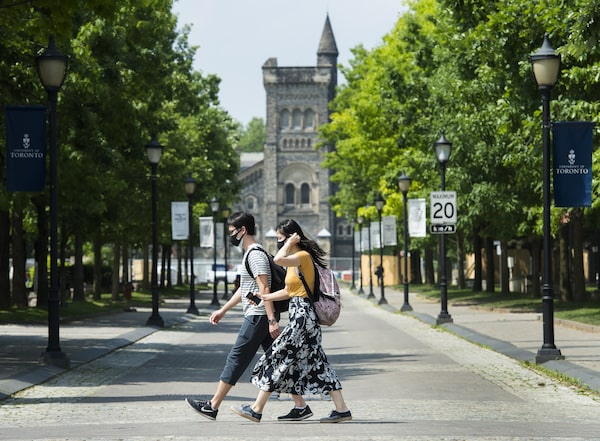
Students walk past the University of Toronto campus in Toronto on June 10, 2020.Nathan Denette/The Canadian Press
Canada’s struggle to process international student visas in time for the start of fall classes jeopardizes a key pathway for potential new immigrants, universities are warning.
And a new report from RBC Economics, released Thursday, outlines the significance of international students to Canada’s immigration strategy and labour market needs, concluding that Canada’s classroom to citizenship process, as it calls it, “needs an urgent reset.”
In recent years Canada has become a favoured destination for international postsecondary students, receiving more than 560,000 study permit applications in 2021. Many have been attracted by policies that encourage students to find work and become permanent residents after their studies.
Canada has also benefited from pandemic border closures in some countries, as well as political currents seen as unfavourable to immigration.
But competing countries are revising those policies in a bid to make their universities and postgraduate work programs more attractive destinations for top talent, said Paul Davidson, the president of Universities Canada, an umbrella group that lobbies on behalf of almost 100 Canadian schools.
The pandemic restrictions that shut down the flow of international students to Australia have been lifted. The Trump-era policies that limited immigration to the United States have been replaced with initiatives aimed at retaining international talent. And the U.K. is emerging from its Brexit debates with postgraduate work policies that mimic Canada’s, Mr. Davidson said.
International students waiting for visas from Ottawa at risk of missing start of classes
Canada's international student recruiting machine is broken
Canada can’t afford to leave students hanging with study permit delays, he said.
“The universities have done an exceptional job of marketing themselves virtually and having students enroll online. That’s the 90 per cent that they need to do. And then if we can’t get [the students] onto campus, it’s a blow, not only for universities,” Mr. Davidson said.
“It’s the third or fourth fall like this, where we have been unable to meet the mark on visa processing.”
Immigration Minister Sean Fraser said this week that his department has prioritized the processing of international study permits but admitted that it will come too late for some students.
Asma Imtiyaz, a 22-year-old from India, was planning to attend York University this fall to pursue a postgraduate certificate in accounting, then secure permanent residency. But she’s been waiting for three months to have her visa approved. Now it seems she will have to defer her offer of acceptance and put her plans on hold for a year, she said.
A large number of students – likely in the thousands – are in the same situation, says the government.
Part of the problem, according to Immigration, Refugees and Citizenship Canada, is that demand is so high. The department said it finalized 360,000 applications this year by July 31, up from 306,000 in the same period a year ago, and expects to complete a further 104,000 in August.
International students, whose numbers have more than doubled in the past decade, have been a financial boon to the Canadian postsecondary system, injecting $6-billion annually in tuition alone at a time when funding from provincial governments has been stagnant.
The share of university income that comes from tuition increased from 21.5 per cent to 28.8 per cent over the past decade, while the share from provincial grants has decreased from 41.5 per cent to 32.5 per cent, according to Statistics Canada. Most of that growth in tuition income has come from international students. Fees for international undergraduates were, on average, a little more than $33,000 last year, compared with about $6,700 for domestic students.
At UBC, for example, international fees brought in more than $545-million in 2020-21, compared with $375-million from domestic students, according to its 2022 budget documents. In Ontario’s college system, international students make up approximately 30 per cent of the student body and supply 68 per cent of tuition revenue, according to a 2021 report from Ontario’s Auditor-General.
The reality of life in Canada for international students
But “as the global war for talent escalates, Canada needs to sharpen its policies to maintain its edge,” the RBC Economics report says. “The country’s recent health care staff shortages are a wake-up call that Canada should be more strategic in leveraging and expanding its international student pool. Looming shortages in STEM, trades and skills needed for the new green economy already hover over the horizon.”
More than 157,000 former international students transitioned to permanent residency in 2021, an indication of the growing importance of international education to Canada’s immigration strategy, the report says. And immigrants with Canadian work and study experience tend to fare better economically, according to RBC, with a median wage of more than $44,000 a year among those admitted in 2018, compared with about $25,000 for those without Canadian experience
International students have characteristics that make them attractive to employers, according to the report. They are twice as likely as a domestic student to have studied engineering and 2½ times as likely to have studied math or science. But a growing number of the international cohort are choosing shorter-cycle college diplomas.
The report makes seven recommendations, including that Canada expand the number of international students who make the transition to permanent residency, with a focus on those trained in STEM, health care and trades connected to the green energy transition.
It also recommends making more work-study opportunities available to international students to assist them in making the transition to the Canadian job market.
Our Morning Update and Evening Update newsletters are written by Globe editors, giving you a concise summary of the day’s most important headlines. Sign up today.
 Joe Friesen
Joe Friesen